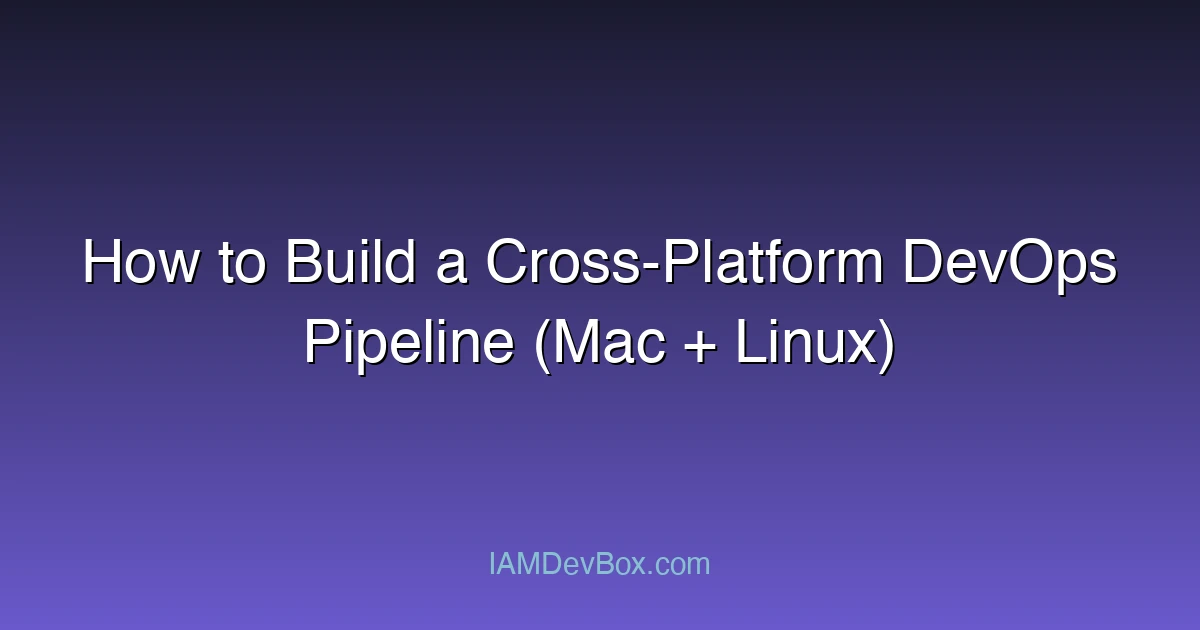In today’s fast-paced software development landscape, having a reliable and efficient DevOps pipeline is crucial. Building a cross-platform pipeline that works seamlessly on both Mac and Linux environments can be challenging but is highly rewarding. In this guide, we’ll walk through the process of creating a robust DevOps pipeline using Jenkins and Docker, ensuring consistency across Mac and Linux platforms.
Visual Overview:
graph LR
subgraph "CI/CD Pipeline"
Code[Code Commit] --> Build[Build]
Build --> Test[Test]
Test --> Security[Security Scan]
Security --> Deploy[Deploy]
Deploy --> Monitor[Monitor]
end
style Code fill:#667eea,color:#fff
style Security fill:#f44336,color:#fff
style Deploy fill:#4caf50,color:#fff
Setting Up Jenkins for Cross-Platform Builds
Jenkins is a popular open-source automation server that supports a wide range of plugins and integrations, making it an excellent choice for cross-platform pipelines. To set up Jenkins, follow these steps:
1. Installing Jenkins
On Mac:
# Install Homebrew if not installed
brew install jenkins
On Linux (Ubuntu/Debian):
# Add the Jenkins repository
wget -q -O - https://pkg.jenkins.io/debian-stable/jenkins.io.key | sudo apt-key add -
sudo sh -c 'echo deb https://pkg.jenkins.io/debian-stable binary/ > /etc/apt/sources.list.d/jenkins.list'
# Update and install Jenkins
sudo apt-get update
sudo apt-get install jenkins
2. Configuring Jenkins for Cross-Platform Builds
Once Jenkins is installed, configure it to handle both Mac and Linux builds. Create a new Jenkins job with the following configuration:
pipeline {
agent {
label 'cross-platform-agent'
}
stages {
stage('Checkout') {
steps {
git 'https://github.com/your-repository.git'
}
}
stage('Build') {
steps {
sh 'mvn clean install' # Example build command
}
}
stage('Test') {
steps {
sh 'mvn test'
}
}
stage('Deploy') {
steps {
sh 'scp target/*.jar user@linux-server:/var/www/html/'
}
}
}
}
This pipeline configuration ensures that the same code is built and tested on both Mac and Linux agents.
Integrating Docker for Cross-Platform Compatibility
Docker is a powerful tool for containerizing applications, ensuring consistency across different environments. By integrating Docker into your pipeline, you can eliminate platform-specific issues.
1. Installing Docker
On Mac:
# Install Docker using Homebrew
brew install docker
On Linux (Ubuntu/Debian):
# Install Docker
sudo apt-get update
sudo apt-get install docker.io
2. Building Docker Images in Jenkins
Modify your Jenkins pipeline to build Docker images:
pipeline {
agent any
stages {
stage('Checkout') {
steps {
git 'https://github.com/your-repository.git'
}
}
stage('Build Docker Image') {
steps {
sh '''
docker build -t your-image-name:latest .
docker tag your-image-name:latest your-registry/your-image-name:latest
'''
}
}
stage('Push Docker Image') {
steps {
sh 'docker push your-registry/your-image-name:latest'
}
}
}
}
This configuration ensures that Docker images are built and pushed consistently across both Mac and Linux environments.
Implementing a CI/CD Pipeline
A CI/CD pipeline automates testing, building, and deployment. Here’s how to implement it:
1. Setting Up Git Integration
Integrate your Git repository with Jenkins to trigger builds on each commit:
pipeline {
agent any
triggers {
gitlab()
}
stages {
// Your stages here
}
}
2. Configuring Environment Variables
Use environment variables to handle platform-specific configurations:
pipeline {
environment {
OS = sh(script: 'uname -s', returnStdout: true).trim()
}
stages {
stage('Checkout') {
steps {
git 'https://github.com/your-repository.git'
}
}
stage('Build') {
steps {
if (OS == 'Darwin') {
sh 'make mac-build'
} else {
sh 'make linux-build'
}
}
}
}
}
3. Automating Deployment
Automate deployment to both Mac and Linux environments:
pipeline {
stages {
stage('Deployment') {
steps {
sh '''
# Deploy to Mac
scp target/*.app user@mac-server:/Applications/
# Deploy to Linux
scp target/*.rpm user@linux-server:/var/www/html/
'''
}
}
}
}
Ensuring Cross-Platform Compatibility
To ensure your pipeline works seamlessly across Mac and Linux, follow these best practices:
1. Use Platform-Agnostic Tools
Choose tools that work consistently across both platforms, such as:
# Example: Using Python for scripting
python3 script.py
2. Write Platform-Aware Code
Modify your code to handle platform-specific behavior:
import platform
if platform.system() == 'Darwin':
# Mac-specific code
elif platform.system() == 'Linux':
# Linux-specific code
3. Test on Both Platforms
Regularly test your pipeline on both Mac and Linux to catch platform-specific issues early.
Conclusion
Building a cross-platform DevOps pipeline using Jenkins and Docker is a powerful way to ensure consistency and efficiency across Mac and Linux environments. By following the steps outlined in this guide, you can create a robust pipeline that automates testing, building, and deployment, saving time and reducing errors.
Next Steps:
- Explore Jenkins Plugins: Enhance your pipeline with additional Jenkins plugins for better integration and reporting.
- Implement Monitoring: Add monitoring to your pipeline to track performance and identify bottlenecks.
- Continuously Improve: Regularly review and optimize your pipeline to adapt to changing project needs.
By investing time in setting up a cross-platform DevOps pipeline, you can streamline your development process and deliver high-quality software consistently.
